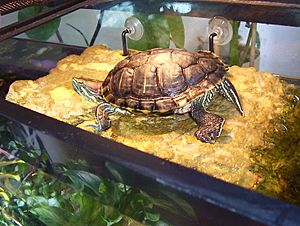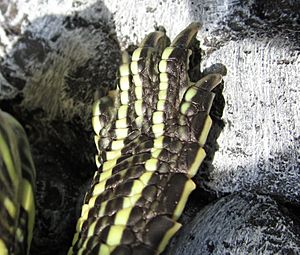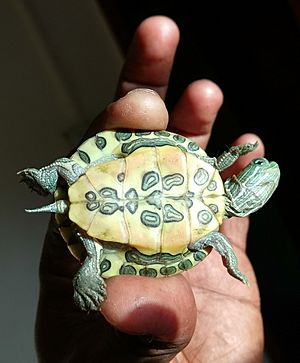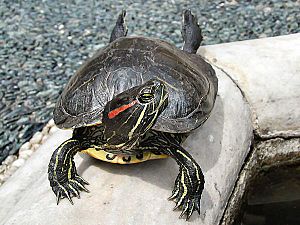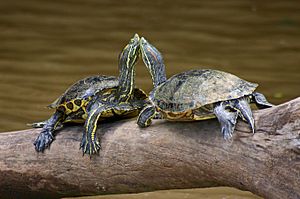Red-eared slider facts for kids
The red-eared slider (Trachemys scripta elegans) is a type of turtle that lives both in water and on land. It belongs to the Emydidae family of turtles. This turtle is the most popular pet turtle in the United States. It naturally lives in the Southern United States. However, you can also find them in many other places, like California, where they were brought by people and are now considered an invasive species.
Quick facts for kids Red-eared slider |
|
|---|---|
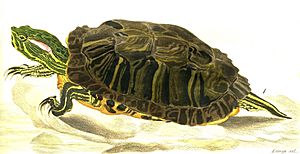 |
|
| A drawing of a red-eared slider from 1865 by Karl Bodmer. | |
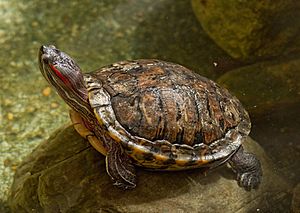 |
|
| At the Cincinnati Zoo | |
| Scientific classification | |
| Kingdom: | |
| Phylum: | |
| Class: | |
| Subclass: | |
| Order: | |
| Family: |
Emydidae
|
| Genus: |
Trachemys
|
| Species: | |
| Subspecies: |
T. s. elegans
|
| Trinomial name | |
| Trachemys scripta elegans (Wied-Neuwied, 1839)
|
|
| Synonyms | |
|
|
Contents
What Do Red-Eared Sliders Look Like?
The shell of a red-eared slider can grow to be over 40 cm (16 in) long. Most turtles are about 15 to 20 cm (6 to 8 in) long. Female turtles are usually bigger than males.
These turtles typically live for 20 to 30 years. Some have even lived for more than 40 years! When they are kept as pets, their lives might be shorter. How well they are cared for really affects how long they live.
Red-eared sliders are cold-blooded animals. This means they cannot control their own body temperature. They depend on the temperature of their surroundings. Because of this, they often need to sunbathe. This helps them warm up and keep their bodies at the right temperature.
Their Shells and Markings
A turtle's shell has two main parts. The top part is called the carapace. The bottom part is called the plastron. The carapace has different sections called scutes. These are bony plates covered in keratin, which is like what your fingernails are made of.
The carapace is oval-shaped and a bit flat. It has a small ridge, called a keel, which is clearer in young turtles. The color of the shell changes as the turtle gets older. Young turtles have a bright leaf green shell. As they age, it becomes darker green, then turns brown or olive green.
The plastron, or bottom shell, is always light yellow. It has dark, irregular markings in the center of most scutes. These markings can look very different from one turtle to another. The turtle's head, legs, and tail are green with thin, yellow lines. All these stripes and markings help the turtle blend in with its surroundings.
Red-eared sliders have partially webbed feet. These feet help them swim well. They can also pull their feet, head, and tail inside their shell if they feel threatened.
The most special thing about red-eared sliders is the red stripe on each side of their head. This stripe is behind their eyes, where their ears would be. This is how they got their name! Sometimes, this red stripe can fade over time. They don't have a visible outer ear. Instead, they have a middle ear covered by a disc of cartilage.
Winter Sleep (Brumation)
Red-eared sliders do not truly hibernate. Instead, they go into a state called brumation. During brumation, they become less active. They might still come up for food or air sometimes.
In the wild, red-eared sliders brumate during winter. They stay at the bottom of ponds or shallow lakes. They usually become inactive in October when temperatures drop below 10 °C (50 °F). During this time, they hardly move, don't eat, and breathe very slowly.
Turtles usually brumate underwater. They can also be found under banks, rocks, or in hollow tree stumps. In warmer places, they might become active and bask in the sun during winter. But if it gets cold again, they quickly go back to brumating. Sliders usually start looking for food again in early March or late April.
If you keep a red-eared slider as a pet indoors, it should not brumate.
Life Cycle and Reproduction
Courtship and mating for red-eared sliders happen underwater. This usually takes place between March and July. During courtship, the male turtle swims around the female. He gently wiggles his long claws near her face and head. This might be to send out special scents called pheromones.
If the female likes him, she will sink to the bottom for mating. If she is not interested, she might become aggressive. Courtship can last about 45 minutes, but mating only takes 10 minutes.
Sometimes, a male turtle might try to court another male. In captivity, they might even do this to other pets. Between male turtles, this can be a sign of who is in charge. Young turtles might do the courtship dance even before they are old enough to mate. This usually happens around five years old.
After mating, the female spends more time basking in the sun. This helps keep her eggs warm. She might also change her diet, eating different foods or less than usual. A female can lay between two and 30 eggs at a time. This depends on her size and other things. One female can lay up to five groups of eggs in a year. These groups are usually laid 12 to 36 days apart.
The female uses her back legs to dig a hole. She then lays her eggs inside it.
The eggs take about 59 to 112 days to hatch. Baby turtles that hatch late in the season might stay in their nest all winter. They will come out when the weather gets warm in the spring.
Just before hatching, the egg is half turtle and half yolk sac. A new baby turtle uses a special "egg tooth" to break out of its egg. This egg tooth falls off about an hour after hatching and never grows back. Baby turtles might stay inside their eggshells for a day or two after hatching.
When a baby turtle leaves its shell, it still has a small yolk sac sticking out from its belly. This yolk sac is very important. It gives the baby turtle food until it is fully absorbed into its body. The baby turtle cannot swim until this sac is completely absorbed and the opening has healed. This usually takes about 21 days from hatching until they can enter the water.
The temperature during the egg's development decides if the baby turtle will be male or female. If eggs are kept between 22–27 °C (72–81 °F), only males will hatch. Warmer temperatures produce females. If it's too cold, the embryos won't survive.
Red-Eared Sliders as Pets
Red-eared slider turtles are the most commonly bought pet reptiles in the world. They are popular because they are usually not too expensive, their food is affordable, they start small, and they are fairly easy to care for. Like other turtles, if they survive their first year or two, they can live for about 30 years.
It's important to know that these turtles can carry salmonella bacteria. This can make people sick. To stay safe, you should wash your hands every time you touch your red-eared slider or the water in its tank. You should also change the aquarium water often. For young turtles, change it once a week. For older turtles, change it at least every two weeks. Using a good aquarium filter system also helps keep the water clean.
When red-eared sliders get older, they can bite, and their bites can be painful. Sometimes, people who don't want them anymore let them go into the wild. This is a bad idea because these turtles can harm the local environment and other animals.
Images for kids
-
A group of baby turtles held by a biologist in Natchez, Mississippi.
-
A line of basking red-eared sliders faces an inquisitive mallard.
See also
 In Spanish: Tortuga de orejas rojas para niños
In Spanish: Tortuga de orejas rojas para niños


